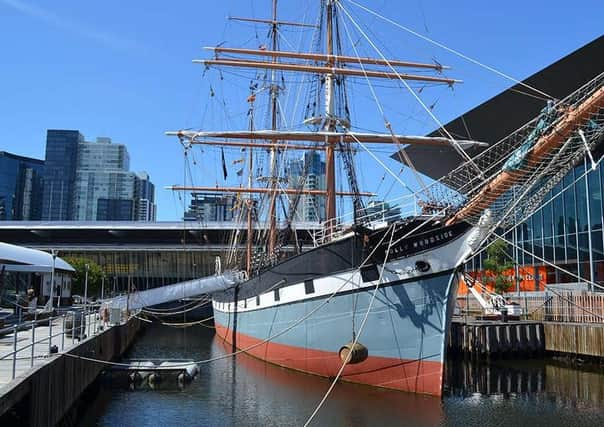Historic Belfast ship in temporary lockdown due to coronavirus


One of my own little mental amendments followed news reports from around the world as the pandemic progressed.
As it neared Europe I remembered places I’d visited down the years as one after another they became overrun with tragedy and illness.
Advertisement
Hide AdAdvertisement
Hide AdAlpine ski resorts, Mediterranean villages, African market towns and European capitals - news of each and every onslaught contrasted horribly with my warmest memories of being there.
More than occasionally on the TV news or in the papers I recognised a hotel where I’d stayed, a market stall where I’d haggled or a street I’d wandered - deserted, eerily quiet, a fearful population in lockdown.
And my thoughts turned to local connections with these places, and people from here who’d made their mark on history, in far away lands now in the shadow of pandemic.
Our famous politicians, military leaders and industrialists, ‘exported’ to every continent. Our explorers, our heroes of two world wars, our scientists, inventors, cultural giants, zealous missionaries and far-flung churchmen.
Advertisement
Hide AdAdvertisement
Hide AdAnd when Australia’s Premier of Victoria, Daniel Andrews, recently announced lockdown following a massive surge in community transmission of coronavirus cases, I immediately recalled that one of Melbourne’s busiest and best-loved tourist attractions comes from Belfast.
For the first time in a century, the New South Wales-Victoria border is closed to help contain the outbreak, and the always-busy public gangway is closed to a little Belfast-built ship in Melbourne with a long and colourful history.
The multi-award-winning Polly Woodside Tall Ship and Museum in the heart of Melbourne’s South Wharf, run by Victoria’s National Trust, is regarded as one of the city’s most iconic and enchanting attractions.
Built and launched in Belfast in 1885, the three-masted cargo vessel carried coal and wheat between England and South America and after travelling 1.7 million kilometres and circumnavigating the world 17 times, the Polly Woodside is now one of Australia’s most popular visitor attractions.
Advertisement
Hide AdAdvertisement
Hide AdBut because of the lockdown it’s temporarily closed until further notice.
The historic little vessel was built by Belfast’s so-called ‘wee yard’ - Workman Clark & Co Ltd - actually one of the largest of the British shipbuilders and only called ‘wee’ because Harland and Wolff was the biggest of them all!
She was iron-hulled, barque-rigged, 192-feet-long, 678 gross tons, capable of around 14 knots with a crew of up to 20 men.
Polly Woodside’s owner was William Woodside, a Belfast ship owner.
He gave the vessel his wife Marian’s nickname - Polly!
Advertisement
Hide AdAdvertisement
Hide AdBetween 1885 and 1904 the Polly Woodside made 17 trips to all parts of the world including South and North America, Australia and Africa and rounded the infamous Cape Horn 16 times.
She mostly carried coal and nitrate, but as the trade began to diminish and returned little or no profit, between 1900 and 1904 the ship went on two round-the-world voyages picking up and discharging cargoes wherever they could be found. This was called ‘tramping’.
In 1904 she was sold to a New Zealand firm and renamed ‘Rona’, operating mostly between Australia and New Zealand.
As she was working in the transition years between sail and steam, the increased competition provided by steamships meant that Rona’s mast and yards were removed and she was towed to Melbourne to be converted into a coal lighter.
Advertisement
Hide AdAdvertisement
Hide AdTwo mishaps occurred in the last years of her sailing career. In March 1920 a schooner in San Francisco harbour collided with Rona at anchor, causing minor damage and in June 1921, carrying a cargo of coal, Rona grounded on Steeple Rock, off Wellington Heads, New Zealand.
Fortunately she was she was able to be towed into Wellington harbour for repair.
In 1922 Rona was sold to the Adelaide Steamship Co. Ltd. for conversion to a coal hulk, transporting coal to steamships.
She came to Melbourne where she refuelled steam ships in the harbour until 1964.
Advertisement
Hide AdAdvertisement
Hide AdFor almost 40 years Rona was one of around two dozen hulks that were in regular use in Hobson’s Bay and the Yarra River re-fuelling ships with coal in the Port of Melbourne.
Due to the 1930’s depression and the increased use of fuel oil, their numbers steadily declined until Rona was the only one left.
Between 1943-1946 she was requisitioned by the Australian Navy for war service, refuelling navy ships in Papua, New Guinea. By the 1960s Rona was becoming dirtier, rustier and less in demand until she was finally laid up at Melbourne’s South Wharf while plans were drawn for her preservation.
In 1968 she was handed over to the National Trust of Australia (Victoria) and sold for just one cent.
Advertisement
Hide AdAdvertisement
Hide AdShe was given back her original name of Polly Woodside and for the next 10 years extensive renovation was undertaken to restore her as closely as possible to her 1885 configuration.
In 1978 the then Governor of Victoria, Sir Henry Winneke, opened the vessel as an onshore museum to the public in Melbourne’s Duke’s Dock.
She was closed in 2006 for major development all around her and in 2011 Polly Woodside reopened on Melbourne’s South Wharf and was enormously popular, till Covid-19 temporarily closed her down.
Comment Guidelines
National World encourages reader discussion on our stories. User feedback, insights and back-and-forth exchanges add a rich layer of context to reporting. Please review our Community Guidelines before commenting.